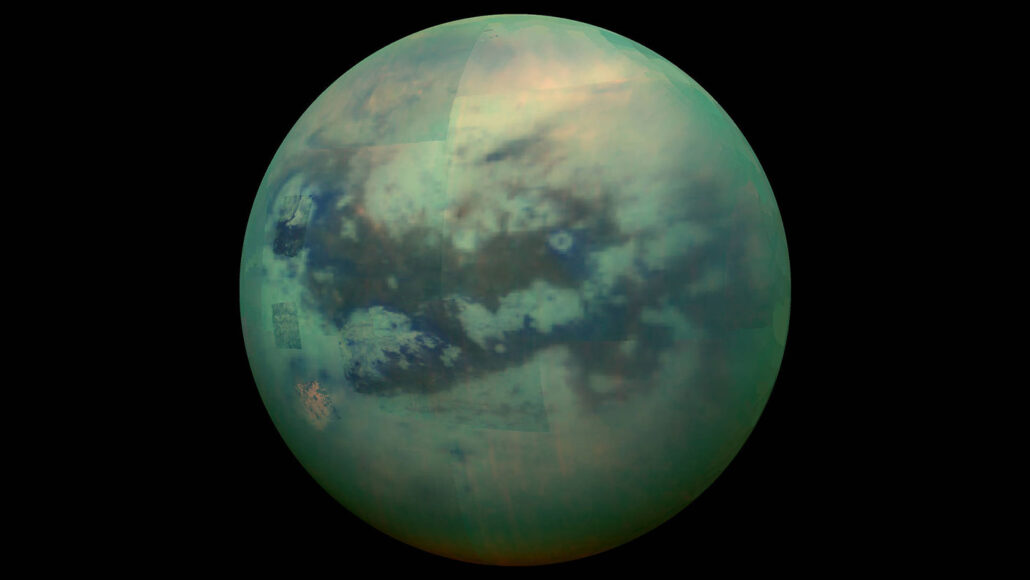Comets may be the source of sandy dunes on Saturn’s largest moon
Titan’s mysterious, shifting waves of sand may have truly ancient origins

Dark regions in this infrared composite photo of Titan were taken in 2015 by NASA’s now-defunct Cassini spacecraft. Those dark sites appear to be dunes of sand, which may come from comets orbiting on the outer edges of our solar system, new analyses suggest.
NASA
By Nikk Ogasa
THE WOODLANDS, TEXAS — The dark dunes of Titan, Saturn’s largest moon, may have fallen from space.
Comets may have formed its vast dune fields, a new study concludes. Computer models suggest the comets may hail from the Kuiper (KY-pur) Belt. That’s a donut-shaped region of the outer solar system located beyond Neptune’s orbit.
This discovery could explain the presence of similar material observed on other worlds, said William Bottke. He’s a planetary scientist who led this new research. Bottke works for the Southwest Research Institute in Boulder, Colo. He shared this research here, on March 12, at the Lunar and Planetary Science Conference.
Scientists have long puzzled over the source of sand on Titan. Beneath this moon’s tangerine skies drift some 15 million square kilometers (5.8 million square miles) of dusky dunes. These waves of sand cover an area roughly as large as the massive desert dunes in the United Arab Emirates. That’s a country in the Middle East. The recent Dune movies were filmed among these earthly mounds.
Titan’s rippling sands consist of particles of organic material that were shed from its hazy atmosphere. After these small particles — only a micrometer (4 hundred-thousandth of an inch) in diameter — fell to the surface, they somehow grew into sand-sized grains that collected as dunes. (The unaided human eye cannot see anything smaller than 40 micrometers. Sand grains are roughly four to 25 times that size.)
But it’s not clear how that particle growth happened. In fact, Bottke noted, lab tests show that the organic particles may break apart too easily to endure being battered into dunes.
Mysteries persist
Bottke proposes another possibility. It begins early in the history of the solar system. We’re talking about some 4 billion years ago.
One of the most popular theories for the solar system’s evolution says that the giant planets didn’t form in their current places. While migrating to where they are now, scientists believe, these planets interacted with the Kuiper Belt. During that grand reshuffling, comets could have bombarded Titan and other moons. Many such comets also would likely have smashed together, forming countless tiny particles.
We know a surprising amount about these dark particles, Bottke said. Many have struck spacecraft and Earth. They’re tough enough to survive passing through our atmosphere. Often some 200 microns wide, they’d be just the right size to build dunes on Titan.
Bottke was part of a team that ran computer models on how Saturn, Jupiter and their moons evolved during this chaotic time. They tracked how much pulverized comet dust and how many larger space rocks fell onto the moons of Saturn and Jupiter.
Do you have a science question? We can help!
Submit your question here, and we might answer it an upcoming issue of Science News Explores
Dust and rocks are “two sources that can potentially do this,” Bottke said. Either one could have delivered more than enough material to account for Titan’s dunes, the study finds.
The models showed that much of the material also struck other moons. These included Jupiter’s Callisto and Ganymede as well as Saturn’s moon Iapetus. These are all known to have large patches of dark material.
The dark material on Iapetus is thought to have come from elsewhere, notes Jani Radebaugh. She’s a planetary geologist who works at Brigham Young University. That’s in Provo, Utah. It’s plausible then that Titan’s sands, too, could have otherworldly origins, Radebaugh says. She did not take part in the new study.
But what if the material that falls to Titan’s surface doesn’t stay there? Ice volcanoes may be erupting on Titan, or have done so in the past. If the comet debris was present as volcanoes were erupting, Radebaugh says, “that would create a problem for this [story].” Over time, eruptions would mix and bury that old, comet debris.
NASA has a mission to Titan that’s slated for launch in 2028. This Dragonfly program could solve the mystery. “It’s a testable hypothesis,” says Melissa Trainer. She’s a planetary scientist who works on Dragonfly out of NASA’s Goddard Space Flight Center. It’s in Greenbelt, Md. Instruments onboard the drone-like space robot will be able to measure details of the dune particles, she says.
Such measurements could confirm claims that seas of shattered comets ripple on a distant moon.







